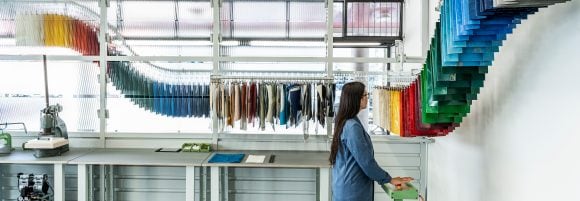Radical transparency
In partnership with The Future Laboratory
About Global Family Office
Life in the old continent yet?
GFO market briefing
Global disruption has brought the fragmented and fragile nature of supply chains into sharp relief, while consumer expectations around transparency and traceability have never been greater.
The cognitive separation between the real and virtual realms is becoming far Transparency has become a buzzword in recent years. But consumer demand for greater visibility of the provenance of products and materials, their journeys within supply chains, and their environmental impact is more than a trend or fad. Instead, it represents the beginning of a new era of radical transparency, where evolving expectations of sustainability, safety, and authenticity are placed front and center of business logistics.
After a year of unprecedented turbulence, we’re now experiencing an epidemic of widespread mistrust of institutions around the world, according to Edelman’s Trust Barometer. But with business the most trusted group globally – trusted by 61% of the global population, ahead of governments, NGOs and the media – enabling customers to examine a company’s supply chain can strengthen that trust. Promisingly, new innovations – from smart materials and packaging to digital identities and blockchain – are providing businesses with the tools to do.
From fragmented and fragile to transparent and traceable
The road to radical transparency has been a long one. In the past decade, demands for decisive action on sustainability have reached unprecedented levels, with the UN’s climate survey – its biggest ever – revealing that almost two-thirds of people across the world say climate change is a global emergency. At the same time, consumers have become increasingly savvy about greenwashing, instead seeking hard evidence that a company has considered, and is working to limit, environmental impact at every stage of a product’s lifecycle.
As Carole Collet, professor in design for sustainable futures at London’s Central Saint Martins, states: “Consumers are more demanding than ever before. Some are literate enough in matters of sustainability that they can walk into a shop and demand to see recycled polyester options over cotton.”
As with many behaviors, the arrival of COVID-19 has accelerated this shift and turned demand into action. According to Accenture, 94% of Fortune 1000 companies experienced supply chain disruptions due to COVID-19, forcing companies to rethink complex global supply chain models and bring transparency and traceability into their core.
The innovation game
As the coronavirus pandemic revealed, an increasingly globalized world has led many businesses’ supply chains to become so large and fragmented that it is difficult to monitor materials and suppliers. For a long time, remedying these issues has proved time-intensive. Fortunately, a new wave of digital innovation is making materials and products traceable once more and bringing visibility to each step of the supply chain.
Labels and packaging manufacturer Avery Dennison, for instance, employs radio-frequency identification (RFID) and blockchain synchronization to create digital ‘birth certificates’ for materials, enabling companies and consumers to trace the movements and origins of products across the entire supply chain.
Volvo Cars, meanwhile, is the first car-maker to implement global traceability of the cobalt used in its batteries by using blockchain technology. Blockchain boosts transparency of the raw material supply chain, which means Volvo and its customers can be assured of the integrity of car parts, responsible sourcing, and compliance with regulations. Such innovations will become increasingly common over the next decade, with the blockchain supply chain market forecast to reach USDbn 9.85 in value by 2025, according to Allied Market Research.
As well as offering assurances of safety and authenticity, enabling consumers to understand the back story of a product means businesses can also provide customers with edifying moments. Lumi ID, for example, is a system that allows businesses to provide transparency to customers by integrating QR codes into packaging. After scanning the code, customers can view answers to FAQs and real-time information about packaging specifications, certifications, and local recycling options.
A problem halved
As well as embracing new digital innovations, many companies are attempting to achieve transparency by shrinking their supply chains or decentralizing production. Doing so not only makes oversight easier, but also represents an eco-conscious way to deliver goods, reducing the impact of e-commerce on the environment.
Unilever is paving the way, trialing a hyper-local manufacturing model that can operate from a 40-feet shipping container and respond faster to local market changes. Using this system links in with Unilever’s wider sustainability goals as it diverts from mass manufacturing and “reflects a new dynamic model where thousands of nano-factories could be run from a central system”, explains Olivera Trifunovic, engineering manager at Unilever.
Whether making their eco-systems smaller or smarter, businesses that embrace radical transparency in these ways can provide customers with the visibility they are demanding, and ensure that, should another great wave of disruption hit, supply chains will remain resilient.
Key implications
Key implications
- A holistic view: Transparency reaches far beyond what a business does with its products when in their custody. Businesses must think about the entire lifecycle of products and offer consumers visibility on what happens before and after a product leaves their care.
- Transparency touchpoints: Traceability is more than a marketing tactic – but it can create marketing opportunities through facilitating the storytelling of a product’s origins, allowing consumers not only to feel the security of knowing where an item has come from, but also an affinity toward it.
- Simplicity speaks: The market can be saturated with confusing terminology. Brands that make information about sourcing and packaging accessible while showing a product’s health and sustainability credentials will win customer loyalty.
- Shrink to fit: Shrinking or localizing supply chains makes transparency easier, reduces environmental impact, and increases the resilience against global uncertainty.
More to explore
More to explore
Ready to start a conversation
Get in touch
The price and value of investments and income derived from them can go down as well as up. You may not get back the amount originally invested.






